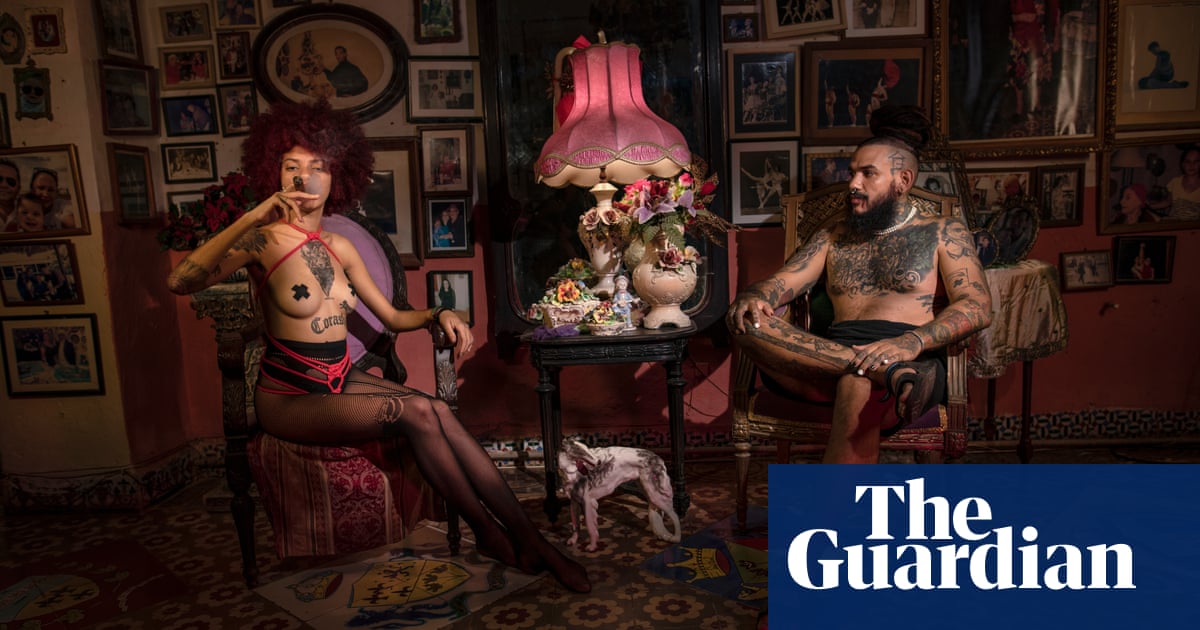I first became intrigued by Cuba three decades ago and have since made numerous trips to the country, some of them focusing on photography. However, I never shared any of my early work as the country had already been extensively photographed and it was challenging to find a fresh perspective. But a few years ago, I started noticing aspects of Cuban life that were previously unseen – subcultures that remain largely unknown to foreigners.
The common perception of Cuba, largely due to its communist regime, is that it is very conventional. I recall being informed that in some Soviet countries, listening to rock’n’roll or wearing jeans was illegal. Foreigners often believe that personal expression is restricted in Cuba, and that everything is uniform and bland. However, this is far from the truth.
In reality, Cuba boasts a diverse range of LGBTQ+ communities, along with enthusiasts of tattoos, piercings, punks, rappers, rockabilly, and bodybuilding. My aim with the New Cubans project was to delve deeper into the underground scene of Havana.
Tattoo parlors were once prohibited in Cuba, but they now appear to be tolerated. The popularity of tattoos has surged in Havana in recent years.
One of the first things I noticed is that young people in Cuba are no longer isolated. The internet became widely accessible only five years ago, prior to which it was quite challenging and inefficient to go online. Today, Cuban youth are connected to the global community, drawing influences from around the world. When I photographed the young individuals for my book, they were eager to share the photos on Instagram.
Similar to youth in any other part of the world, Cubans have become more progressive and liberated. This aspect often surprises foreigners, revealing that Cuba is actually quite permissive and has been at the forefront of LGBTQ+ rights in Latin America.
The photograph captured in 2021 marks the beginning of the series. My collaborator, Devon Ruiz, introduced me to a former Cuban National Ballet director’s home. While the house exuded a nostalgic charm from the past, the young people inside could have easily fit into Berlin, Tokyo, or LA. The stark contrast inspired me to return and photograph Katy and Felix.
Felix leads a weekly shibari workshop, teaching the art of Japanese bondage. It’s akin to an unconventional arts and crafts session. Katy, a participant in the workshop, had initially studied chemistry at university but later pursued art and modeling. Her strong, self-assured demeanor intrigued me, and I aimed to capture that attitude in the photograph. Many individuals in my photos strive to amplify their identities.
While tattoo parlors were once outlawed in Cuba, they are now tolerated, leading to a surge in tattoo popularity, especially in Havana over the past five years. Katy’s topless pose in the photo was their own suggestion.
Shibari does not inherently have a sexual connotation, but nudity is often involved. Felix proposed including the cigar in the image – the only one in the entire project. It felt like a subtle act of defiance. The photograph highlights the contrast between Cuba’s traditional values and the progressive outlook embraced by this generation.
The New Cubans project is a cultural endeavor rather than a political one. Nonetheless, it’s crucial to acknowledge the current challenges in Cuba. The recent economic downturn has had severe repercussions, prompting many to leave the country. The Cuban government estimated that 10% of the population has emigrated in the past two years alone.
A significant portion of these emigrants are young individuals. Nearly a third of those I photographed have departed the country since the photos were taken. At one point, the project almost felt like an attempt to capture images of social circles that are swiftly disintegrating. Katy informed me recently that she has relocated to Montreal, underscoring the transient nature of life in Cuba.
Jean-François Bouchard’s CV
Born: Montreal, 1968
Trained: “Lawyer gone rogue/self-taught.”
Influences: “I’ve been influenced by photographers at the complete ends of the photographic spectrum. Conceptual artists who are part of the ‘Vancouver School’ of photography (Jeff Wall, Rodney Graham, Stan Douglas) and their imaginary worlds at one end, at the other, photojournalists and documentarians rooted in reality (Lauren Greenfield, Diane Arbus, James Nachtwey). The Cuban photographer Alejandro González was also a significant inspiration.”
High point: “Having a career. It is so hard to make photography more than a pastime that I still can’t quite believe I am now regarded as a professional. I suffer from acute impostor syndrome.”
Low point: “Spending tons of money and time shooting a project that turned out to look great, but on a flawed and disrespectful premise. I had to scrap the whole thing.”
Top tip: “Kill your babies. As image makers, it is easy to fall in love with your photographs. But you must love your career more and that means killing most of the work. Unless your name is Wolfgang Tillmans, don’t show dozens upon dozens of images in an exhibition.”
Jean-François Bouchard’s photobook The New Cubans is published on 19 November. Order here (UK) or here (rest of world) and follow @jfbouchard1 for more of his work.
